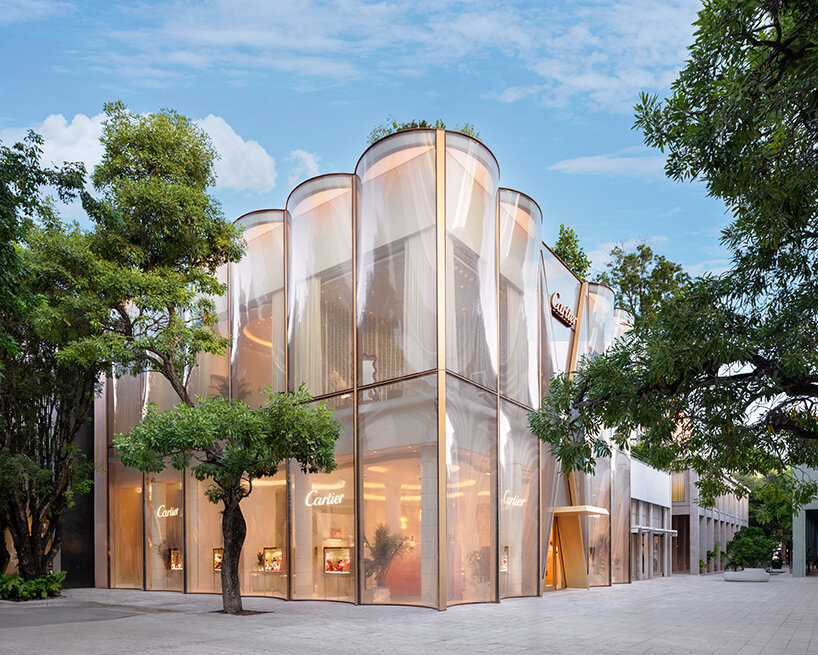Simple Geometry Shines in Modern Minimalist Home in Israel
2017-11-26 12:29
Architects: Pitsou Kedem Architects Project: Modern Minimalist Home in Israel Location: Savyon, Israel Architect in Charge: Hila Sela Design Team: Pitsou Kedem, Hila Sela Area 700.0 sqm Project Year 2016 Photography: Amit Geron
建筑师:Pitsou Kedem建筑项目:以色列现代极简住宅地点:Savian,以色列建筑师:Hila Sela设计组:Pitsou Kedem,Hila Sela建筑面积700.0平方米,2016年摄影:Amit Geron
From the architect: Since the dawn of history, ‘public’ architecture – the architecture constructed by institutions of church and state, served as a tool in shaping the consciousness of the masses. Its massive dimensions, layout of spaces, and choice of materials, were all done with the objective of creating in the viewer and visitor a sense of moving between dimensions – from the day-to-day, the simple and the often inferior – to a place that is sublime, inspiring and of awesome majesty – homes to those among the people raised to privilege– the representatives of God on earth.
来自建筑师:从历史的开始,“公共”建筑-由教会和国家机构建造的建筑,作为塑造大众意识的工具。它的巨大尺寸,空间布局,以及材料的选择,都是为了在观众和游客中创造一种在不同维度之间移动的感觉-从一天到一天,简单的和往往低劣的-到一个崇高、鼓舞人心、令人敬畏的地方-这是那些被提升为特权的人们的家园-上帝在地球上的代表。
The Pharaohs in Ancient Egypt, influenced by the Nile which flows in linear manner, designed their temples as a voluminous physical experience. En route, temple visitors move over long stretches that become more convoluted and ever deeper, passing through spaces where each exposes a clue to the next, and where each transition appears to take you closer to the exalted and the shocking, which only the favored will get to see.
古埃及的法老们,在尼罗河的影响下,以线性的方式流动,把他们的庙宇设计成一种巨大的物质体验。在途中,庙宇的游客会经过一段更复杂、更深的地方,穿过每一个地方,每一个地方都暴露出一条线索给下一个人,每一个过渡似乎都会让你更接近那些被尊崇和震惊的人,只有最受欢迎的人才会看到这些。
Western modern architecture sought to break free of its propaganda-based foundations and serve as a reflection of the values of a society, its culture, and its technological capabilities. It is intended to serve the public and the objectives of a nation’s government – no longer in the form of holy places, but as functional public buildings that are welcoming and democratic in nature. Accordingly, the importance of changing the mind-set of the visitor has been almost entirely absent from the design discourse in recent centuries.
西方现代建筑试图打破其以宣传为基础的基础,作为社会价值、文化和技术能力的反映。它的目的是为公众和国家政府的目标服务-不再以圣地的形式出现,而是作为欢迎和民主性质的功能性公共建筑。因此,近几个世纪来,改变游客思维方式的重要性几乎完全没有出现在设计讨论中。
When it comes to ‘grassroots architecture’ – namely, the architecture used in planning private residences – the experience of a change in consciousness upon entering a house is hardly ever thought of nowadays in the design process, having lost its importance quite some time ago. The living spaces and the living room are thus made as one piece, separated from the street by nothing more than a door, both physically and metaphorically.
说到“草根建筑”-即规划私人住宅所使用的建筑-在设计过程中,人们很少想到进入一所房子时意识发生变化的经历,因为它在相当长一段时间前就失去了它的重要性。因此,客厅和客厅是一体的,与街道相隔无非是一扇门,无论是物理上还是隐喻上都是如此。
The house under discussion here is about this experience. It is this dynamic that is generated in its design, explaining it to the visitor simply by placing him or her at its center from the first moment they stand in front of the facade facing the street — an opaque monolithic slab, covered in dark stone. The impermeability of the wall is softened by an avenue of young trees directing the visitor along the length of the paved footpath, directly into an inner courtyard surrounded by a semi-opaque stretch of wood, the first in a series of internal courtyards that form a key principle in the design of this modern minimalist home.
这里讨论的房子就是关于这个经历的。正是这种动态产生于它的设计中,它向游客解释,仅仅是从他们第一次站在面对街道的正面的那一刻起,他们就把他或她放在它的中心-一个不透明的整体板,上面覆盖着黑色的石头。这堵墙的防渗性被一条小径软化了,这条林荫道引导游客沿着铺好的人行道,直接进入一个由半不透明的木头环绕的内部庭院,这是一系列内部庭院中的第一个,构成了这座现代简约主义住宅设计的一个关键原则。
Walking along the path, as indeed the entry into the enclosed grounds, is part of the process of separating from the outside world and contemplating the present moment more deeply. Full attention can now be given to the structure, captured in its spaces like a prisoner – as we stand in front of a large, transparent curtain wall on which we can observe what is going on in the house in absolute transparency, something reserved for visitors invited because they appreciate such loveliness.
沿着这条路走,就像进入封闭的地面一样,是与外界分离并更深刻地思考当下的过程的一部分。现在,我们可以充分关注这座建筑,它就像一个囚犯一样被它的空间所捕捉-当我们站在一堵大而透明的幕墙前时,我们可以绝对透明地观察房子里发生的事情,这是留给被邀请来参观的游客用的,因为他们欣赏这样的可爱。
Although the facade facing the street is designed as an opaque mass and seems to hold an enigmatic secret, as soon as one crosses the line of the wooden ‘arbours’, the spaces of the house are suddenly visible in all their simplicity. The process of stepping into opaqueness and then catching sight of the private interior as it emerges from the sealed, the hidden, and the monolithic, into an open and light-filled space, would almost seem to confirm that you have entered the place now exposed – the private parts of the house. Here the geometry is simple and minimalist, and is clean and transparent in its form and materials, almost as if it were someone that had turned all his cards face up on the table.
虽然面对街道的正面被设计成一个不透明的块状,似乎有一个神秘的秘密,但只要一个人穿过木雕线,房子的空间就会突然显现在它们所有的简单性上。当私人内部从密封的、隐藏的、整体的空间出现,进入一个开放的、充满光线的空间时,逐步进入不透明,然后才能看到私人内部的过程,似乎几乎证实了你已经进入了现在暴露的地方-房子的私人部分。这里的几何学是简单和极简主义的,它的形式和材料是干净和透明的,就好像是有人把他所有的牌都翻到桌子上了一样。
The other internal courtyards, as well as the glass balustrade that encloses the swimming pool, separating it from the other outside spaces, seemingly bring together all the visitor’s experiences into a focused and penetrating experience, one that clearly spells out the boundaries of what is permitted and possible, and defines the house as a private and intimate experience.
其他内部庭院,以及环绕游泳池的玻璃栏杆,将游泳池与其他外部空间隔开,似乎把游客的所有体验集中在一起,形成了一种专注而深入的体验,一种清晰地阐明了允许和可能的界限的体验,并将这所房子定义为一种私人和亲密的体验。
 举报
举报
别默默的看了,快登录帮我评论一下吧!:)
注册
登录
更多评论
相关文章
-

描边风设计中,最容易犯的8种问题分析
2018年走过了四分之一,LOGO设计趋势也清晰了LOGO设计
-

描边风设计中,最容易犯的8种问题分析
2018年走过了四分之一,LOGO设计趋势也清晰了LOGO设计
-

描边风设计中,最容易犯的8种问题分析
2018年走过了四分之一,LOGO设计趋势也清晰了LOGO设计










































































